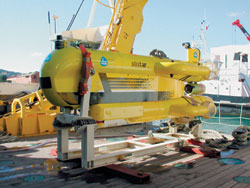 Technology from Europe: Technology from Europe:
France
Latest sea trials for new AUV with payload
The French company, ECA, specializes in design and manufacture of underwater robotics. The company’s affiliate, HYTEC, specializes in designing and building of remote-controlled systems for TV inspection, measurement and maintenance within hostile environments such as nuclear power plants, waste process and storage areas, pipes for gas, water and industry, and boreholes for ground water. Together, they are nearing completion of testing of a new Autonomous Underwater Vehicle (AUV) named ALISTAR (see figure).
The new AUV is multipurpose and designed for 300-m and 3,000-m depths. A 300-m demonstrator was first tested at sea in early 2002, and the results were presented during the UDT 2002 European Conference at La Spezia, Italy. A demonstration was also performed in the Brest harbor at this time to illustrate the navigation capabilities of the vehicle.
 |
New AUV being readied for sea trials.
|
|
The main applications are inspection related as the first step toward intervention, but the system is also capable of performing high-quality survey missions. Other applications include pipe-touchdown monitoring, inspection of underwater equipment (pipelines, cables, wellheads, etc.) monitoring of riser connection and disconnection, wreck inspection, acoustic cartography and generation of optical mosaics.
The 300-m model is a 600-kg vehicle, powered by four longitudinal propellers, and two vertical thrusters, which provide high maneuverability. The dimensions are 3.2m long, 1.1m wide and 1.3m high. Its power source includes modules of secondary lithium-ion batteries. The maximum velocity is about 8 kt. The vehicle can be run in a fully autonomous mode and, optionally, with a fiber optic link. The computer system comprises:
- The surface computer system, including a control console dedicated to the manual-control mode, and a mission management console
- The vehicle internal computer systems, with three boards: Mission management board, Command and Control board and Navigation board.
Surface communication is based on a radio Ethernet link. ECA and IFREMER Toulon, France, have conducted a new series of at-sea trials called ETAC3, to evaluate ALISTAR’s capacity to carry scientific payloads and to perform bottom following for payload data-acquisition. Despite bad weather conditions (sea state up to 8), the mission was successful.
In early 2003, the demonstrator was prepared to be run with a scientific payload to perform data acquisition. The payload, provided by IFREMER, consisted of CTD (Conductivity, Temperature, Depth) and ADCP (Acoustic Depth Current Profiler) sensor packages. These sensors were integrated into the vehicle and were protected by a new fairing. It should be noted that the mechanical, electrical, electronic interfaces of the new AUV are designed to accept most payloads (sonar, cameras/lights, sensors, etc.).
The trials took place at the beginning of February off Toulon, with the mother ship Europe provided by IFREMER. The payload data was collected and stored in the vehicle using an Ethernet protocol, and downloaded after the vehicle was recovered. The navigation sensor suite included high-precision sensors: a Workhorse Doppler log from RDI; a PHINS inertial navigation system from iXSEA; and a GPS for periodic surface-position update. Also, four GPS-Intelligent Buoys (GIBs) were deployed before launching the vehicle, for real-time display of the vehicle’s position.
Trials were run between four and five kt with bottom-following, automatic control in fully autonomous mode. They led to validation of the:
- Integration of payload on the AUV
- Good dynamic behavior of the AUV with this payload
- Interfacing of the payload and payload data acquisition through vehicle internal communication means
- Bottom-following functionality.
Future scientific trials will take place in summer with a new payload to gather data for ocean modeling. 
|

 Technology from Europe:
Technology from Europe:

